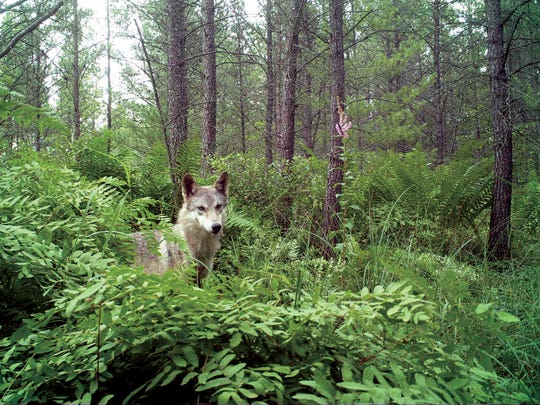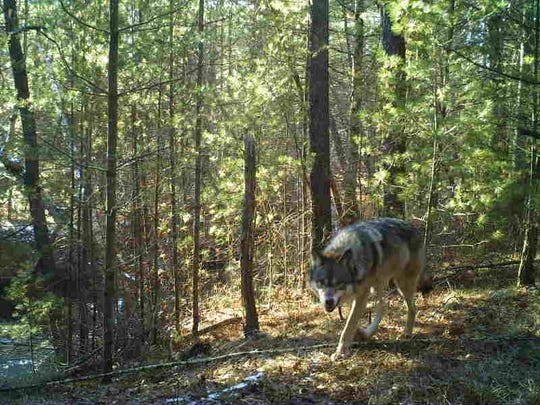Paul A. Smith, Milwaukee Journal Sentinel
As my vehicle came over a slight rise, a large, heavily-furred animal came into view.
It stood in a forest opening just yards off the highway shoulder.
I hit the brakes to get a better view: Big, blocky snout, long legs, slate-colored coat with white accents.
From dogs of similar size I have known, I guessed it weighed 90 pounds.
All signs pointed to one thing, a gray wolf.
I did a u-turn at the first available spot and returned to the site, but the animal was gone.
Was it an apparition? Or the real thing?
That encounter, in the early 1990s along Highway 63 north of Solon Springs, was the first time I believe I saw a wild wolf in Wisconsin.
Since then I have since seen at least a dozen, including three in one morning while hunting ruffed grouse in Taylor County. All sightings have been fleeting and non-confrontational.
Each also produced a sense of awe unlike any other wild animal encounter I’ve had in the state. The wolves were swift, elusive and, to my eye, handsome.
Over the last several decades as their numbers have risen, the odds have increased that you, too, have seen a wild wolf in Wisconsin.

A wolf is shown in this trail cam photo from Snapshot Wisconsin of the Wisconsin Department of Natural Resources. (Photo: Wisconsin Department of Natural Resources/Wisconsin Snapshot)
Did you come away thrilled? Or filled with hatred, fear and loathing?
Our perceptions of wolves depend in large part on circumstances and values.
A farmer trying to keep livestock in northern Wisconsin is apt to think very differently about wolves from a wildlife watcher who catches a glimpse of an animal in a remote block of public forest.
The management status of wolves, too, influences how people feel about the species. If lethal control is allowed, farmers are more likely to accept wolves, studies show. Illegal killings also drop.
However, over the last couple decades wolves have been part of a veritable tennis match of delisting and listing under the federal Endangered Species Act.
Wisconsin has seen three periods of state authority to manage wolves, said Scott Walter, large carnivore ecologist with the Department of Natural Resources. At present, the species is protected under the ESA; no lethal control is allowed.
In March, the U.S. Fish and Wildlife Service announced its most recent attempt to delist the species in the Lower 48 states. A public comment period runs through May 14. A decision is expected in summer.
Proponents of the plan consider the species recovered in prime habitat, such as Wisconsin’s northern and central forests.
Randy Jurewicz, a retired DNR manager who helped write the state’s 1999 wolf plan, said not only do wolves deserve to be delisted, but people deserve the species delisted, too.
The wolf population in the Great Lakes region has grown from about 450 wolves in Minnesota in the 1960s to at least 4,222 wolves in Minnesota, Michigan and Wisconsin in 2018, Jurewicz said.
And with regard to people, ranchers have paid for wolf recovery with “the blood of their cattle, the sweat from all the extra work wolves have caused them and the tears of worry they have suffered,” Jurewicz said. State and federal wildlife staff, as well as donors to the state’s endangered resources fund, have all worked for delisting, too.
Most state conservation groups, including Wisconsin’s Green Fire and Wisconsin Wildlife Federation, also favor returning the wolf to state control.

A wolf is shown in this trail cam photo from the Wisconsin Department of Natural Resources. (Photo: Wisconsin Department of Natural Resources)
Some opponents of delisting don’t believe the wolf is adequately protected under some state plans, including Wisconsin’s. Others simply don’t believe the wolf should be hunted or trapped and would prefer to see the species protected indefinitely.
Ojibwa tribes in Wisconsin, for example, include wolves in their creation story and don’t believe the animal should be hunted or trapped.
Jodi Habush Sinykin, on behalf of John Muir chapter of the Sierra Club, opposed delisting because the DNR has failed to update its 1999 Wolf Management Plan with science-based goals and recommendations, failed to reform its state law “immediately mandating recreational hunting of wolves as soon as they are delisted” and failed to outlaw “the barbaric practice of using dogs to hunt wolves.”
Habush Sinykin also noted the important ecological role wolves play and that the species has been shown to self-regulate its numbers.
Wolves are native to Wisconsin but were considered extirpated by the middle 20th century due to unregulated hunting, poisoning and bounties.
Recolonization of wolves from Minnesota into northwestern Wisconsin began in the mid-1970s, and by 1980 five packs established territories in the Badger State, according to DNR reports.
Aided by protections of the 1973 Endangered Species Act, wolf numbers in Wisconsin increased to 25 in 1980, 34 in 1990, 248 in 2000 and 704 in 2010, according to state estimates.
Following a 2012 delisting, Wisconsin held wolf hunting and trapping seasons in 2012-14, killing 117, 257 and 154 wolves, respectively.
The wolf population showed a decline during the brief period of state management.
At the time, the DNR expressed its objective to “put downward pressure on the wolf population.” But it did not state a wolf population goal at the time.
The agency also did not perform a long-awaited update to its wolf management plan.
In December 2014 wolves in the western Great Lakes region were placed back under protections of the ESA when a federal judge ruled management plans in Wisconsin and other states weren’t sufficient to safeguard the population.
At the time, the DNR said it wouldn’t revise its management plan until it regained authority to manage wolves.
Wolf numbers increased over the next three years, including to a record high 925 to 956 wolves in 2016-17. The wolf study is conducted in winter, when the animals are easiest to count and the population is at its annual low.

Wolf captured on trail cam. (Photo: Wisconsin Department of Natural Resources)
The number decreased 2% over the next year, to a minimum of 905 wolves and 238 wolf packs, according to the DNR, and could be a sign the population of the apex predator is leveling off.
It could have also been an indication of increased illegal killing of wolves. Federal officials have issued a reward for information related to poison placed earlier this year in several northern Wisconsin counties. Several pet dogs, as well as wild animals, died after eating poison-laced meat.
The 2018-19 Wisconsin wolf population report is expected to be released in June; another minimum count of 900 or more is anticipated by most experts.
So how many wolves should we have in Wisconsin?
It’s possible wolves are now showing us the biologically carrying capacity, Walter said. Wolf packs have filled most, if not all, available wolf habitat in the state.
The social carrying capacity – what humans will tolerate or support – is a more complex issue.
The most recent indication of Wisconsinite’s views on wolves was garnered in a 2014 DNR public attitude survey when the state had a minimum of 660 wolves.
Among survey respondents in wolf range, 53% wanted wolf numbers maintained at current levels or increased in their county of residence, while 18% wanted wolves decreased and 15% wanted them eliminated.
Outside of wolf range, 56% wanted wolf numbers maintained or increased statewide.
Now that the state likely has more than 900 wolves, it’s unknown if public sentiment is similar or has changed.
What is clear is wolf depredation on livestock decreased when the state had the ability to use lethal control, said David Ruid, supervisory wildlife biologist for the U.S. Department of Agriculture.
In 2010 and 2011, 47 and 40 farms, respectively, in Wisconsin had confirmed or probable wolf depredations when the species was protected by the ESA.
From 2012 to 2014, when wolf harvest and lethal control was available, the depredation numbers fell to 32, 28 and 22, respectively, Ruid said.
“If we’re going to be responsible wildlife managers, we really need to have lethal controls available,” Ruid said.
The Wisconsin Wolf Management Plan approved in 1999 and 2007 set a goal of 350 wolves.
However, the number was based on outdated information and before wolves had an opportunity to expand into more habitat in the state, said Jurewicz, the retired DNR manager.
Jurewicz said the 350 goal was developed “a long time ago and is no longer reasonable.” He would recommend 900.
A campaign mounted in recent years to set a lower goal resulted in county resolutions in half the state. Thirty-six county boards are on record supporting a statewide population goal of 350 or fewer wolves.
It will fall to the DNR to determine where to set the number. What is best to serve the needs of Wisconsin’s residents and wildlife?

Scott Walter is large carnivore ecologist for the Wisconsin Department of Natural Resources. (Photo: Paul A. Smith)
Although the federal delisting process will likely take months and its outcome is uncertain, the “wheels are turning” inside the DNR to prepare for the day the state again has authority to manage wolves, Walter said.
Should that happen, Walter said the DNR would reconvene its wolf management committee of stakeholders and begin planning for a wolf hunting and trapping season as required by state law.
Could it happen in 2019? It’s unlikely given the current timeline.
What is certain is people will continue to have disparate views on wolves.
“This is a contentious issue, but we don’t make headway by throwing bombs and conspiracy theories at each other,” Walter said. “Trust and respect will be required as we work to continue the successful management of this species.”
Wolf comment period: In March, the U.S. Fish and Wildlife Service published its proposed wolf delisting rule in the Federal Register. The public may comment on the proposal through May 14. All comments will be posted on regulations.gov.
To comment on the proposed rule electronically, click here and then click on the “comment now” tab. Alternatively, visit fws.gov.
Source:
